The advent of internet and the tremendous interconnectivity it created between people comes with the downside of less checks for the validity of the information. Nowadays everyone can have a website and share information, without restrictions on the content quality.
Understanding the lying patterns in order to be able to detect lies is a difficult task. More research in natural language processing is needed, as well as more psychological studies and data. In this project, we take a small step in this direction, performing analysis of labelled political statements.
Politics is a widely debated topic with direct impact on people’s lives. Most modern states in Europe and North America are based on representative democracy, where vital decisions regarding the future of the country are taken by representatives chosen through vote. Trusting those people is therefore a vital, but not an easy task. There is a strong incentive of deforming the truth or lying in the election campaign to gain more votes, or during their mandate in order to keep a position of power.
Another related problem of modern society are the fake news. Media companies strive to create high impact news, not always reporting the truth.
In this project, we perform an analysis of the Liar dataset, a dataset of political statements from PolitiFact, looking at cues for determining the truthfulness of a statement. We also experiment with some machine learning models to get more insight into the data and extrapolate this insight into new statements.
The Liar dataset
A great challenge for deception detection is the lack of a large amount of labelled data. We have used for our analysis the Liar dataset (Wang, 2017). This is, to the best of our knowledge, one of the biggest datasets of statements labelled according to their truthfulness.
Unfortunately, while the dataset provides a lot of information regarding the context of the statement, which receives a certain classification from 6 classes of truth, it has only about 12000 entries. The relatively low number of entries, as well as the predominance of statements from the US politics, does not allow for a good generalization. However, there is enough data for an analysis of the US political statements from the past decade.
The political language
Since we are dealing with natural language, we decided to start our analysis by examining the vocabulary present in the dataset. In general, a similar word distribution over the statements is expected, given that all the statements are political and made in English. However, our focus is finding words that tend to have a higher precedence in a particular truth class.
This is a relatively small dataset, with a body of almost 190 000 words. However, with almost 12 000 unique tokens (we count ‘home’ and ‘homes’ as 2 different tokens), it has a variate vocabulary, many words appearing just once or twice. For comparison, a publication by Laufer et al, 2010, indicates that understanding 8000 word families leads to a 98% vocabulary coverage in an average English spoken discourse, with as little as 3000 word families (5000 lexical items) necessary for a minimal reading comprehension (Laufer (1992), Adolphs (2003)). Note that these publications talk about word families and lexical items, while we count tokens.
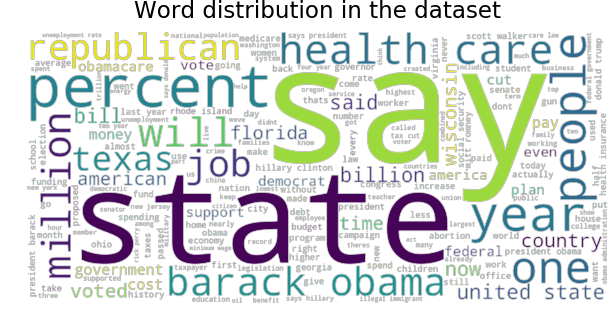
Looking at the most common words in the dataset, we can observe the main topics of discussion in politics at the time, such as health care or Barack Obama, as well as some features of the political speech, such as the prevalence of percentages or years. Also, topics of interest for politics such as bill, vote or government are present amongst the most used words in this dataset.
Although the dataset has 6 levels of truth, we analyze the language used in true and false statements in general, looking for differences in words usage.
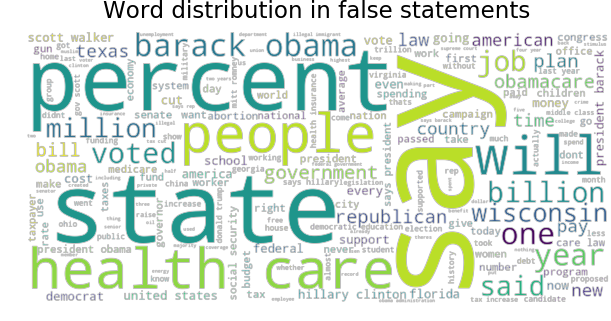
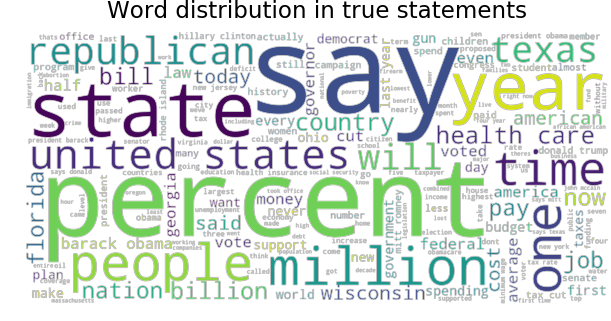
We can make a few remarks on the words usage. The word ‘million’ is more used in true statements, while the word ‘billion’ is more used in false statements. This can suggest a tendency of exaggeration. Also, ‘percent’ and ‘year’ tend to be less used in false statements, possibly indicating a tendency in the lack of precision. ‘Health care’, ‘obamacare’ and ‘Barack Obama’ are also more present in untruthful statements. This is an interesting fact - since a large part of the dataset overlaps with the Barack Obama’s presidency, health care being a controversial topic at the time.
Subjects people talk about
The dataset has over 12000 statements discussing 145 unique subjects, such as economy, climate change or immigration. We focused our analysis on the 54 subjects, each with more than 100 statements:
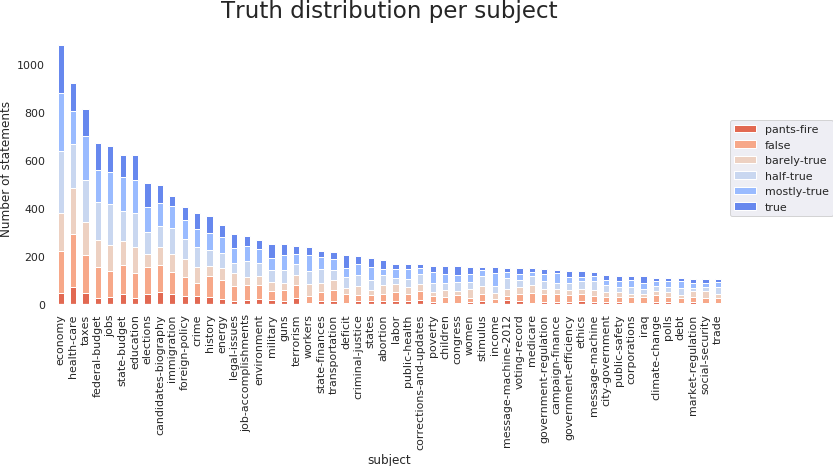
The economy and the health care are the most commonly used subjects in the dataset. As noticed from the language analysis, health care and Medicare are the subjects with the largest proportion of lies, while income and poverty rates appear more often in true statements:
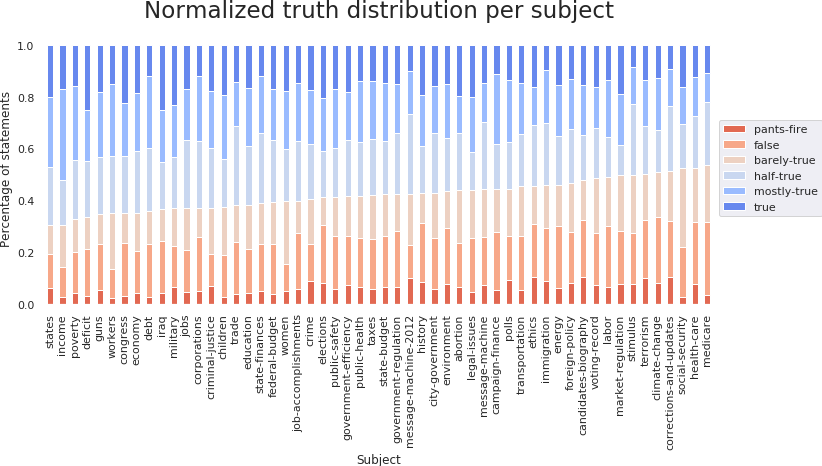
Who is speaking
We perform a similar analysis on the speakers. The statements in the dataset have been made by 3310 unique speakers, such as Donald Trump or Ron Jonson, or sources such as Blog or Facebook Posts. We look at the 29 speakers with more than 50 statements.

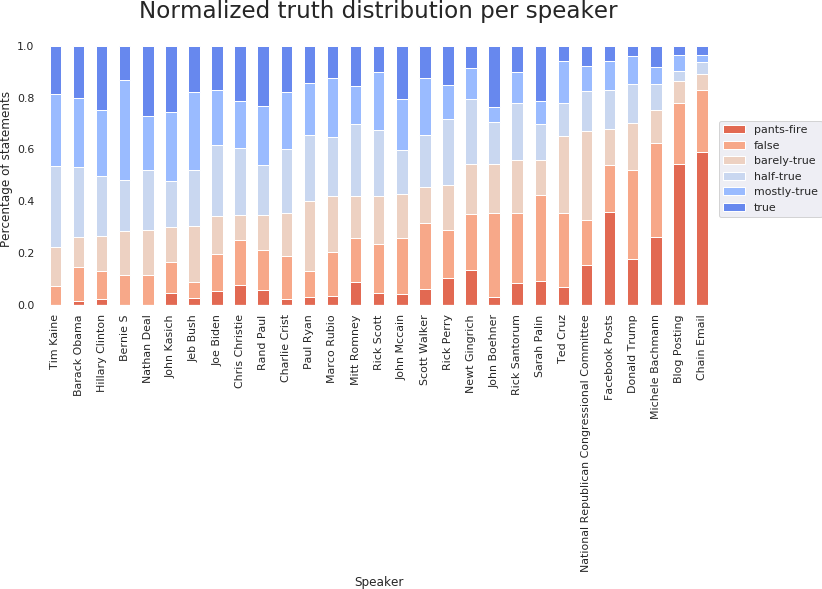
We notice that Barack Obama, Donald Trump and Hillary Clinton have the most statements. The normalized truth distribution visualization is a good indication of the trustworthiness of a politician. Barack Obama and Hilary Clinton are amongst the most reliable, with relatively few deceptive statements compared to unreliable sources, such as Blog Posts, or other politicians, such as Donald Trump.
Another remark is that, according to the available data, Facebook posts are more reliable in general than blog posts. Chain emails are the worst source of information, with the highest number of lies. This is an interesting premise to follow in trying to determine the best source for information, but more data would be needed for a definite answer.
Since this analysis is performed over a small dataset, its generalization is based on the assumption of uniform sampling of the dataset. However, at such low statement counts, it is very possible that the sampling introduced some bias.
What are speaker’s professions
Another relevant feature for the trustworthiness of an individual might be their profession. In the Liar dataset, 803 professions are represented, with 18 of them having over 50 samples.


The most frequently encountered jobs are political positions, the most common being senator and house member. This is expected, considering that the statements are political. Looking at the normalized distribution, the president is the most reliable source, with under 30% of the statements being classified as lies.
Unsurprisingly, the social media is remarkably unreliable, with a high number of outrageous lies. All the statements of a President Elect belong to Donald Trump, while 611 out of the 615 presidential statements belong to Barack Obama. This correlates with the speaker trustworthiness analysed above, with Barack Obama being one of the most trustworthy people.
Political affiliation
Over 84% of the speakers in our dataset have 3 political affiliations, being democrats, republicans or with no political affiliations.
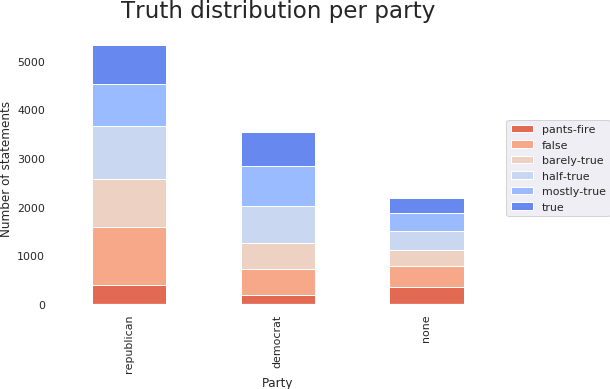
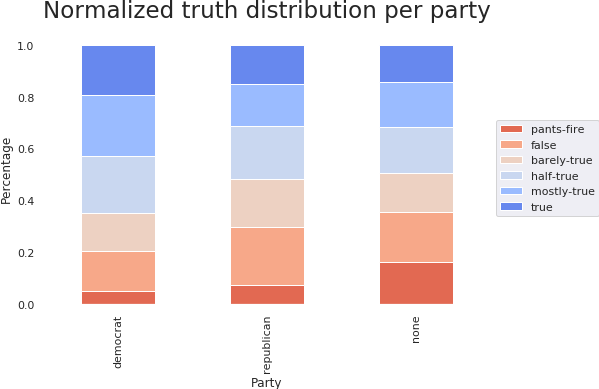
In general, there is a tendency of the democrats to be more sincere than the republicans. Barack Obama made only 15% of the democrat statements and Donald Trump only 6% of the republican ones. We have found that removing these 2 people does not change the general trend, republicans still having about 10% more untruthful statements than democrats.
This is possibly due to the political context in which the data has been sampled - the republican opposition might have had an incentive to bend the truth to consolidate its position. We again note that this is a conclusion reached based on a small dataset and intuition regarding the political context, being by no means a definitive statement.
The people with no political affiliation have a relatively high number of untrue statements. This is likely due to the unreliable sources included in this category, such as blog posts.
Social media vs. public figures on hot topics
We do a short comparison of the trustworthiness between social media sources, such as Facebook posts, chain email, and statements from public figures, looking at two widely debated topics in politics, health care and income.
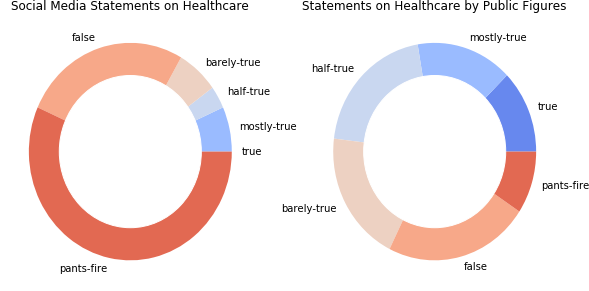
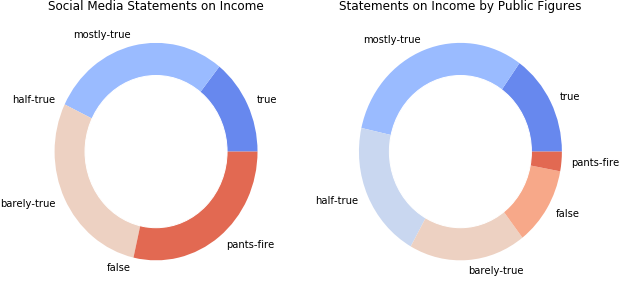
On both topics, the social media is much more unreliable than public figures. We can motivate this by the lack of any filter of the social media, anyone being able to post their opinion. Public figures on the other hand, have earned the trust of a group (such as a political party) and might have more to lose by lying.
Note that in this analysis, statements made by public figures on social media are attributed to their author, and not to the social media class.
Do people use numbers in lies?
There is an old proverb saying that numbers don’t lie. The presence of numbers in a statements might indicate its trustworthiness, due to various biases that occur when people lie.
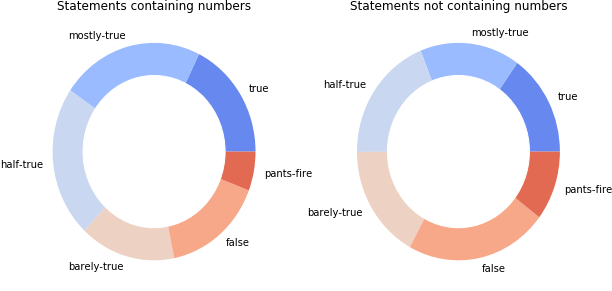
The statements that contain numbers tend to have a higher truth ratio, most likely due to the precise nature of numbers. However, this is not definitory: there is still about a third of statements that contain numbers and are untruthful.
Sentimental analysis
When analysing features of the natural language, especially when considering a context such as politics which people can get passionate about, the sentimental analysis might be insightful.
Unfortunately, the quantitative analisys does not suggest any strong bias in any of the classes:
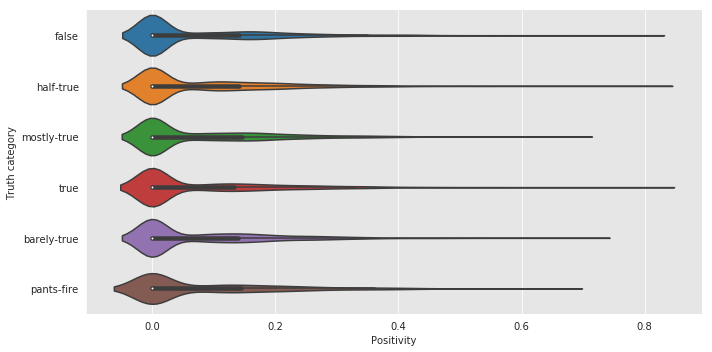
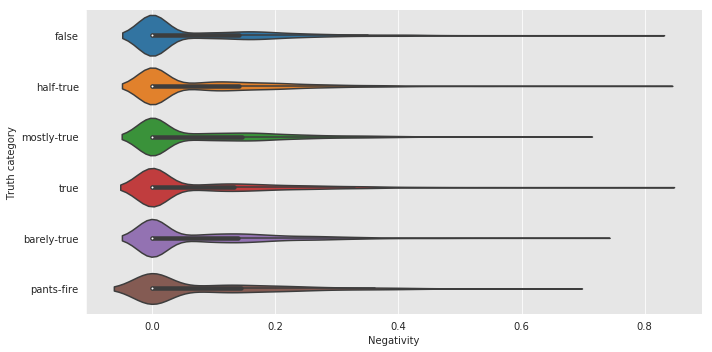
Most important features in discriminating lies
Now we can answer the most important question: what is the most important feature of a statement that can be used to determine its truthfulness.
Using machine learning approaches for a definitive classification is very difficult, especially when considering the complexity of the problem and the limited size of the dataset. The original publication Liar dataset (Wang, 2017) manages to achieve only about 30% accuracy in classification.
We have trained multiple classifiers on the dataset, in an attempt not to gain high accuracy, but to get more insight into which features are more informative in classification.
A naive Bayes classifier trained on the statements themselves shows the words that occur the most in various classes. To ease the interpretation of this analysis, we have split the dataset in only two classes, true and false statements. In this case, takeover is the most informative word, being 11.5 more likely to be in false statements. scheme, Cuccinelli, socialist, showed, illegals, McAauliffe and are also words that appear 7 to 9 times more likely to be in false statements.
We have augmented the dataset with the output from a naive Bayes statement classifier, sentiment analysis, presence of numbers and trained a random forest. Looking at the most informative features, the most relevant is the output of the naive Bayes classifier (which encodes the statement), followed by the metrics for sentiment analysis.
The remaining features are: subject - taxes, subject - health care, party - republican, party - democrat, context - a speech, state - Florida, context - a television ad, subject - immigration.
As expected from the previous analysis, there are hot topics such as taxes and health care that, by their controversial nature and political context, are more likely to be lied about or more likely to be discussed truthfully. Also, the political affiliation plays an important role, as discussed above.
So, what to look for?
The analysis we performed shows some “red flags” in political statements. The results we found are not definitive, but they show some statistical trends in the dataset we analyzed. One of the highest differences we observed was between statements from social media and from public figures, the former being much more unreliable. Other remarks of interest include the presence of some controversial topics, such as health care, and the trustworthiness of some public figures, such as Barack Obama. Also, we looked at some features of the deceiving statements, such as the tendency to avoid numbers.